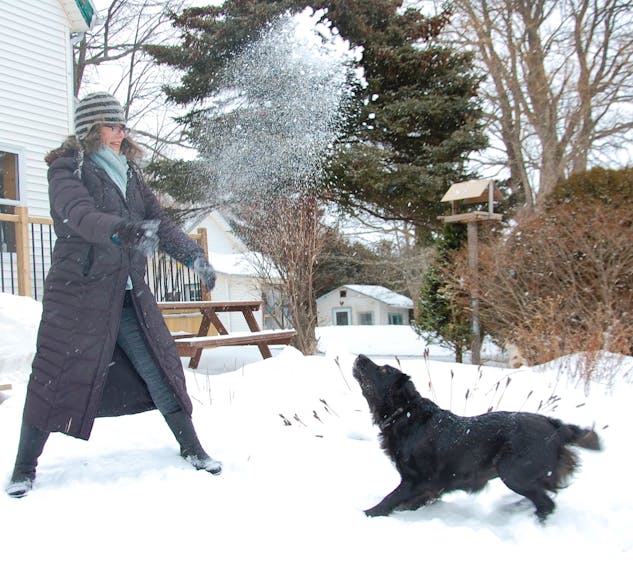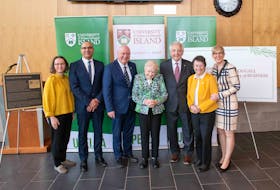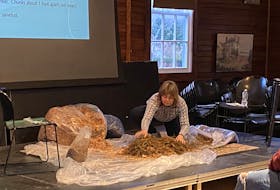Julain Molnar did not believe she was a candidate for heart disease.
A former dancer, the 54-year-old Stratford woman has long enjoyed an active, healthy lifestyle.
She describes herself as a plant-based eater that is roughly 98 per cent vegan.
After lunch one day almost two years ago, Molnar experienced radiating chest pressure and slight pain.
“It could have been indigestion,’’ she recalls.
“That’s what it felt like – except it sort of didn’t.’’
She chose to err on the side of caution. She went to the hospital.
While waiting for test results, a doctor believed Molnar was likely indeed simply experiencing indigestion.
Far from the case.
Molnar’s troponin levels were elevated and her EKG was slightly irregular. She was admitted to hospital where she had another episode.
She went to Halifax for additional tests eight days later and, after much discussion and some uncertainty, it was decided that she most likely had spontaneous coronary artery dissection (SCAD).
By the numbers
- Women are 10 times more likely to die from heart disease, stroke and related vascular conditions than from breast cancer.
- Heart attacks are more deadly for women, and women are more likely to suffer a second heart attack than men. Pregnancy, menopause and hormonal changes affect women’s risk.
- Eighty-eight per cent of spontaneous coronary artery dissection (SCAD) patients are women, many young and otherwise healthy. SCAD is the most common cause of pregnancy-associated heart attacks.
Source: Heart and Stroke

SCAD is a potentially fatal condition where the heart’s artery walls start tearing apart. Eighty-eight per cent of SCAD patients are women, many young and otherwise healthy.
In most cases, as was the case with Molnar, women have no traditional risk factors for heart disease and no warning signs. And when it happens, SCAD is often under-diagnosed because it can be difficult to detect on traditional angiograms.
After many appointments, drugs and lots of research, Molnar’s SCAD seemed to point to large amounts of migraine medication that she had taken for 15 years.
She had been prescribed migraine medication, which caused the lining of her arteries to contract. She was taking a lot more than the recommended dose per month and was unaware of the danger.
She has since drastically reduced her pain medication and has gone through four months of cardiac rehab that, she said, provided “incredible support’’ and valuable information.
“To be in a room full of people who have experienced something similar to you and to talk about it, it was very emotional,’’ she says.
Molnar is telling her story as a cautionary tale to other women.
“Consider yourself a candidate (for SCAD) no matter what – and I don’t mean be scared,’’ she says.
“I mean educate yourself …. (Women) need to know what’s possible and how to prevent it from happening or if it happens they need to go right away (to the hospital).’’
Molnar feels she is doing everything in her power to remain healthy and to prevent – or be well prepared for – another SCAD incident.
“I think the best thing to do going forward is to trust that I live a healthy lifestyle…and to trust that I know the symptoms,’’ she says.
“By investing in research focused on women, we are gaining the knowledge to save more lives and create better outcomes. But much remains to be done. Women are still paying too high a price for gaps in research, prevention, diagnosis and treatment.’’
Signs of SCAD
If you experience an episode of spontaneous coronary artery dissection (SCAD), you may have any of these symptoms:
- Chest pain, pressure, tightness or heaviness
- Rapid heartbeat, fluttery feeling
- Pain in arms, shoulders, jaw, neck, back or stomach
- Excessive sweating
- Unusual/extreme exhaustion
- Nausea, vomiting
- Dizziness/lightheadedness
- Fainting/loss of consciousness
- Headache
Source: Heart and Stroke
Dr. Jacqueline Saw, a leading expert on spontaneous coronary artery dissection (SCAD), says she has seen “horror stories’’ of women in their 30s and 40s turned away from the ER despite heart attack symptoms.
Saw has developed a way of helping doctors detect SCAD, and with support from Heart and Stroke, her team has identified genes that increase the risk of SCAD. Within the next five years, she expects to see genetic screening tools, much better rates of diagnosis and better treatment protocols.
The new Heart and Stroke report, released Thursday, shows funding for research on women is yielding results.
The report, called Spotlight on Women: A fighting chance, focuses on the stories of three women with life-threatening diagnoses and how new research can transform their lives as they face sex and gender challenges.
Biological differences
Anne Simard, chief mission and research officer with Heart and Stroke, notes there are real biological differences between the sexes.
“Women’s hearts are smaller, with smaller coronary arteries, and plaque builds up in their blood vessels differently,’’ she says.
“By investing in research focused on women, we are gaining the knowledge to save more lives and create better outcomes.
“But much remains to be done,’’ adds Simard. “Women are still paying too high a price for gaps in research, prevention, diagnosis and treatment.’’
To see the full report, visit www.heartandstroke.ca/mediacentre.
The Heart and Stroke Foundation of Canada was rebranded as simply Heart and Stroke in late 2016. Heart and Stroke is a charity dedicated to advocacy, education and the funding of research surrounding heart disease and stroke.









